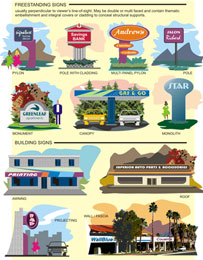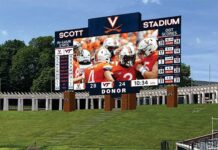 Richard Crawford
Richard Crawford
The United States Sign Council (USSC) has published the new Model On-Premise Sign Code (2011), which is being released to members this month in both printed and electronic formats (which will facilitate its use by municipalities and make editing a simple task). This code replaces the Guideline Code for the Regulation of On-Premise Signs (2001).
The new USSC Model Sign Code represents the culmination of over fourteen years of research on the design characteristics of on-premise signage. Since 1998, the USSC, through its research arm, the United States Sign Council Foundation (USSCF), has published fourteen major academic studies covering the full range of on-premise sign legibility, placement, illumination, community impact, and traffic safety issues. This work has enabled the USSC to develop guideline standards and models based on empirical research, which have also been used and published by other professional organizations. The new Model Code synthesizes this research and incorporates its principles into a practical sign ordinance format.
Because of this research, USSC was able to craft sign regulations that were in concert with observable human factors performance criteria. The new code is based on the objective observations and measurements that are the result of this research effort—in that on-premise signs function as a principal means of roadside communication and situational awareness for motorists.
The state-of-the-art 2011 Model Code can be a firm buttress to guard against attack on the code based on apparent subjectivity or lack of sustainable performance evidence. The document contains these features:
(1.) The writers drafted the Model Code to conform to the way that codes are typically written and applied across the country. A town can simply add its name and make a few cosmetic changes to the document and use the mas presented.
(2.) It tackles two major issues that local municipalities often have difficulty in addressing, in an objective and practical way, and provides much-needed guidance: on-premise sign area/sign height appropriate by zoning district and traffic conditions, and on-premise sign illumination levels at night.
The research USSC has performed regarding on-premise sign sizes and sign heights forms the basis for the determination of the dimensional characteristics of on-premise signage, in the interests of the motorist and traffic safety. This is a science-based approach supported by already-recognized USSC guidelines and standards. Both freestanding signs (perpendicular) and wall signs (parallel) are covered.
Meanwhile the new code provides a clear and easy-to-understand method of determining allowable on-premise sign lighting levels (or so-called sign brightness). The 2011 USSC Model Sign Code is the first to incorporate the research findings of five on-premise sign lighting studies, all completed since 2004.
The luminance standard advanced in the code applies to all types of illuminated, on-premise signs: internally illuminated signs, externally illuminated signs, and even electronic message centers (EMCs). Even though all would be covered by the code standard, this doesn’t mean that all signs will have the same brightness; it does mean that all signs will have a maximum brightness as set by the Model Code, thereby eliminating the need for different standards for different types of signs. The brightness or luminance of a sign can be determined before the sign is installed or in the field after installation. Complicated and subjective concepts such as “lighting zones” and the need to determine “ambient lighting conditions” are therefore unnecessary in the Model Code, because the motorist’s demonstrated need for a certain sign luminance level at night is independent of other lighting conditions.
The brightness or luminance of a sign can be determined before the sign is installed or in the field after installation. Complicated and subjective concepts such as “lighting zones” and the need to determine “ambient lighting conditions” are therefore unnecessary in the Model Code, because the motorist’s demonstrated need for a certain sign luminance level at night is independent of other lighting conditions.
Implicit in this standard is the fact that on-premise signs aren’t lighting fixtures or outdoor lighting devices and aren’t used to illuminate a task or area. The lighting is used to properly display protected First Amendment communication at night, at a lighting level that complies with the needs of the intended viewer (which is—in 99.9 percent of all cases—the motorist).
(3.) Electronic message centers are allowed by zone, and operational parameters are included to allow EMCs to function to their fullest capabilities.
(4.) Throughout “author’s clarification notes” are included wherever additional description or clarification is needed. This commentary is intended to explain the suggested code language or give more background information to the community that may be reviewing the document.
(5.) Color illustrations are included in the Model Code itself, so that any layperson could read and understand the concepts and various types of signs being regulated—wall signs, roof signs, and so forth. These illustrations are also included to avoid any possible confusion at the municipal level, when the zoning or building department is asked to implement the new code. And in case a municipality is publishing or printing in black-and-white only, gray-scale illustration images are provided too.
We’ll be distributing the new Model Code on CD to planners and attendees at the USSC booth at the American Planning Association’s (APA) national conference this April in Boston. We look forward to interacting with these planning professionals, and USSC is committed to maintaining lines of communication with the APA in the interests of the sign industry as a whole.











